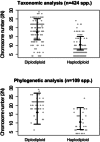The evolutionary dynamics of haplodiploidy: Genome architecture and haploid viability
- PMID: 26462452
- PMCID: PMC4989469
- DOI: 10.1111/evo.12792
The evolutionary dynamics of haplodiploidy: Genome architecture and haploid viability
Abstract
Haplodiploid reproduction, in which males are haploid and females are diploid, is widespread among animals, yet we understand little about the forces responsible for its evolution. The current theory is that haplodiploidy has evolved through genetic conflicts, as it provides a transmission advantage to mothers. Male viability is thought to be a major limiting factor; diploid individuals tend to harbor many recessive lethal mutations. This theory predicts that the evolution of haplodiploidy is more likely in male heterogametic lineages with few chromosomes, as genes on the X chromosome are often expressed in a haploid environment, and the fewer the chromosome number, the greater the proportion of the total genome that is X-linked. We test this prediction with comparative phylogenetic analyses of mites, among which haplodiploidy has evolved repeatedly. We recover a negative correlation between chromosome number and haplodiploidy, find evidence that low chromosome number evolved prior to haplodiploidy, and that it is unlikely that diplodiploidy has reevolved from haplodiploid lineages of mites. These results are consistent with the predicted importance of haploid male viability.
Keywords: Acari; chromosomal evolution; haplodiploidy; reproductive strategies; sex determination.
© 2015 The Author(s). Evolution published by Wiley Periodicals, Inc. on behalf of The Society for the Study of Evolution.
Figures


Similar articles
-
The evolution of haplodiploidy under inbreeding.Heredity (Edinb). 2000 Feb;84 ( Pt 2):186-92. doi: 10.1046/j.1365-2540.2000.00643.x. Heredity (Edinb). 2000. PMID: 10762388
-
The evolution of haplodiploidy by male-killing endosymbionts: importance of population structure and endosymbiont mutualisms.J Evol Biol. 2010 Jan;23(1):40-52. doi: 10.1111/j.1420-9101.2009.01854.x. Epub 2009 Nov 9. J Evol Biol. 2010. PMID: 19903219
-
Gene-rich X chromosomes implicate intragenomic conflict in the evolution of bizarre genetic systems.Proc Natl Acad Sci U S A. 2022 Jun 7;119(23):e2122580119. doi: 10.1073/pnas.2122580119. Epub 2022 Jun 2. Proc Natl Acad Sci U S A. 2022. PMID: 35653559 Free PMC article.
-
The evolution of alternative genetic systems in insects.Annu Rev Entomol. 2003;48:397-423. doi: 10.1146/annurev.ento.48.091801.112703. Epub 2002 Jun 4. Annu Rev Entomol. 2003. PMID: 12221039 Review.
-
Understanding Admixture: Haplodiploidy to the Rescue.Trends Ecol Evol. 2020 Jan;35(1):34-42. doi: 10.1016/j.tree.2019.08.013. Epub 2019 Nov 6. Trends Ecol Evol. 2020. PMID: 31703819 Review.
Cited by
-
A ZZ/ZW Sex Chromosome System in Cephalochordate Amphioxus.Genetics. 2020 Mar;214(3):617-622. doi: 10.1534/genetics.120.303051. Epub 2020 Jan 24. Genetics. 2020. PMID: 31980449 Free PMC article.
-
A database of amphibian karyotypes.Chromosome Res. 2019 Dec;27(4):313-319. doi: 10.1007/s10577-019-09613-1. Epub 2019 Jul 23. Chromosome Res. 2019. PMID: 31338646
-
Males That Silence Their Father's Genes: Genomic Imprinting of a Complete Haploid Genome.Mol Biol Evol. 2021 May 19;38(6):2566-2581. doi: 10.1093/molbev/msab052. Mol Biol Evol. 2021. PMID: 33706381 Free PMC article.
-
Genomic insights into mite phylogeny, fitness, development, and reproduction.BMC Genomics. 2019 Dec 9;20(1):954. doi: 10.1186/s12864-019-6281-1. BMC Genomics. 2019. PMID: 31818245 Free PMC article.
-
Sex Determination, Sex Chromosomes, and Karyotype Evolution in Insects.J Hered. 2017 Jan;108(1):78-93. doi: 10.1093/jhered/esw047. Epub 2016 Aug 20. J Hered. 2017. PMID: 27543823 Free PMC article.
References
-
- Borgia, G. 1980. Evolution of haplodiploidy – models for inbred and outbred systems. Theor. Popul. Biol. 17:103–128. - PubMed
-
- Bull, J. 1979. An advantage for the evolution of male haploidy and systems with similar genetic transmission. Heredity 43:361–381.
-
- Bull, J. J. 1983. The evolution of sex determining mechanisms. Benjamin Cummings, Menlo Park, CA.
Publication types
MeSH terms
LinkOut - more resources
Full Text Sources
Other Literature Sources
